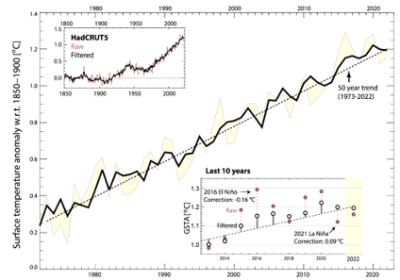Steady Global Surface Warming Through 2022, After a Recent Step Up in Warming Rate
PCMDI Scientists and colleagues have used a novel tool to filter out the noise of climate variability to better extract the underlying signal of global mean surface warming. This reduces the influence of short-term natural fluctuations like El Nino events on global warming trends, and allows for a clearer assessment of the rate of warming and whether it is changing over time.
Using this novel filtering approach, the team finds that the warming rate has remained remarkably steady through time, including during recent periods of prolonged La Nina occurrence. However, there is some indication that the observed warming rate shifted into a larger regime after about 1990. Global climate models as a whole struggle to reproduce these features.
The change in global mean surface temperature is a crucial and broadly used indicator of the evolution of climate change. Any decadal-scale changes in warming rate are however obfuscated by internal variability. Here we show that the surface temperature increase through the recent La Nina-influenced years (2022) is consistent with the 50-year trend of 0.18 °C/decade. We use an Earth System Model-based tool to filter out modulations to the warming rate by sea-surface temperature patterns and find consistent warming rates in four major global temperature data series. However, we also find clear indications, in all observational series, of a step-up in the warming rate since around 1990. CMIP6 models generally do not capture this observed combination of long-term warming rate and recent increase.

